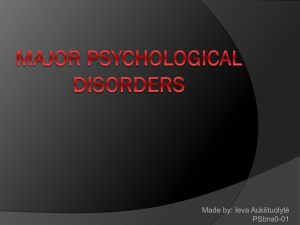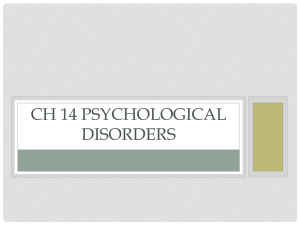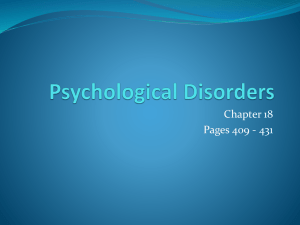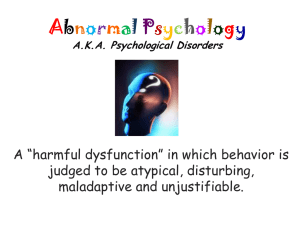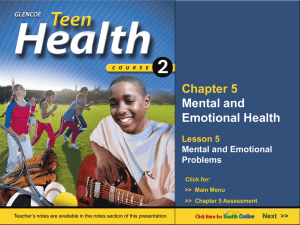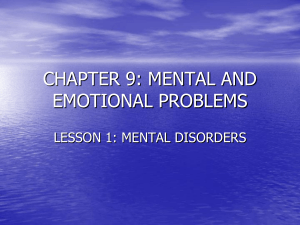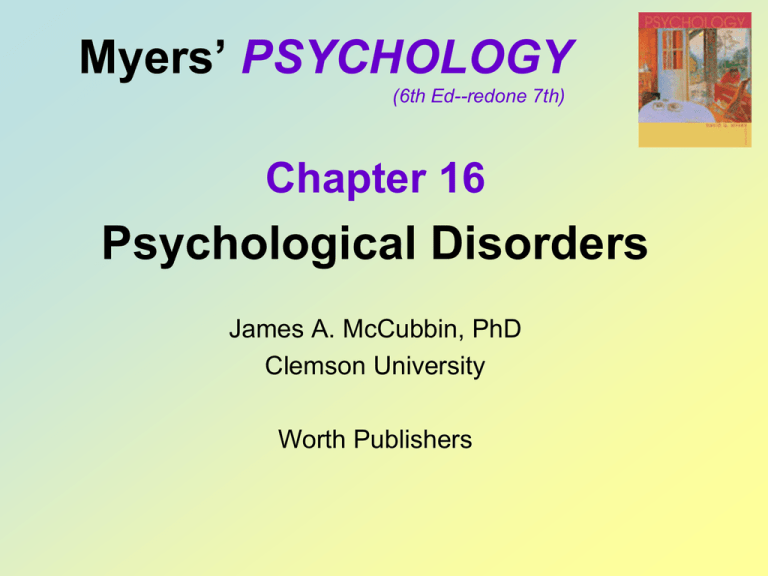
Myers’ PSYCHOLOGY
(6th Ed--redone 7th)
Chapter 16
Psychological Disorders
James A. McCubbin, PhD
Clemson University
Worth Publishers
David Rosenhan suspected that terms such as sanity,
insanity, schizophrenia, mental illness, and abnormal might
have fuzzier boundaries than the psychiatric community
thought.
He also suspected that some strange behaviors seen in
mental patients might originate in the abnormal
atmosphere of the mental hospital, rather than the patients
themselves.
Education
・AB, Yeshiva College, 1951
・MA, Columbia University,
1953
・PhD (psychology),
Columbia University, 1958
Professor, Stanford
University
Dangers of Labeling
David
Rosenhan Being
Sane in Insane
Places
In 1973 sociologist
David Rosenhan
designed a clever
study to examine the
difficulty that people
have shedding the
"mentally ill" label. He
was particularly
interested in how
staffs in mental
institutions process
information about
patients.
Rosenhan & seven associates had themselves
committed to different mental hospitals
complaining of hearing voices. All but one were
diagnosed as schizophrenic.
•Once admitted, they acted totally normal.
•Remained hospitalized for average 19 days (9 to
52)
•Only the patients detected their sanity
•When discharged their chart read,
“schizophrenia in remission”
No professional staff member at
any of the hospitals ever realized
that any of Rosenhan’s
pseudopatients was a fraud.
According to a study conducted by the National
Institute of mental health:
*15.4% of the population suffers from diagnosible
mental health problems
*56 million Americans meet the criteria for a
diagnosible psychological disorder (Carson 1996, Regier
1993)
*Over the lifespan, +/- 32% of Americans will suffer
from some psychological disorder. (Regier1988)
Normal or Abnormal?
Not easy task:
*Is Robin Williams normal?
Anna Nicole Smith? Marilyn
Manson? Karl Rove?
*Is a soldier who risks his life
or her life in combat normal?
*Is a grief-stricken woman
unable to return to her
routine three months after
her husband died normal?
Is a man who climbs
mountains as a hobby
normal?
Some abnormalities are easy:
Hallucinations (false sensory experiences)
Delusions (extreme disorders of thinking)
Affective problems (emotion: depressed, anxious,
or lack of emotion)
CORE CONCEPT:
Medical model: takes a “disease” view
Psychology model: interaction of biological, mental, social,
and behavioral factors
SHOW:
Psych in Film, Ver.2, #33, Patch Adams
Psychological Disorder
– a “harmful dysfunction” in which
behavior is judged to be:
• atypical- (not enough in itself)
• disturbing- (varies with time & culture)
• maladaptive- (harmful)
• unjustifiable- (sometimes there’s a good
reason)
Show
THE WORLD OF AbNORMAL
BEHAVIOR:
#1 Looking at Abnormal Behavior
#2 The Nature of Stress
Carol D. Ryff argues that we must define mental illness
in terms of the positive. She names 6 core
dimensions:
1) Self-acceptance:
positive attitude towards self
multiple aspects of self
positive about past life
2) Positive self relations with other people:
warm, trusting, satisfying interpersonal relationships
capable of empathy, affection, intimacy
3) Autonomy
independent, self-determined
able to resist social pressures
4) Environmental mastery:
sense of mastery and competence
makes good use of opportunities
creates contexts that support their personal needs
5) Purpose of Life:
has goals and directedness
feels there is meaning to past and present life
6) Personal Growth:
see oneself as growing and expanding
open to new experiences
change in ways that reflect self-knowledge and
effectiveness
Historical Perspective
Perceived Causes
*movements of sun or moon
*lunacy- full moon
*demons & evil spirits
Ancient Treatments
*exorcism, caged like animals, beaten,
burned, castrated, mutilated, blood
replaced with animal’s blood
Historical Perspective
Hippocrates (400 bc)
*first step in scientific view of mental disturbance.
*imbalance (excess) among four body fluids called “humors”
Humors
Origin
Temperament
Blood
heart
sanguine (cheerful)
Choler (yellow bile) liver
choleric (angry)
Melancholer
spleen melancholy(depressed)(black bile)
Phlegm
brain
phlegmatic (sluggish)
Psychological Disorders
Medical Model
*concept that diseases have physical causes
*can be diagnosed, treated, and in most
cases, cured
*assumes that these “mental” illnesses can
be diagnosed on the basis of their
symptoms and cured through therapy,
which may include treatment in a
psychiatric hospital
Psychological Disorders
Biological
(Evolution,
individual
genes, brain
structures
and chemistry)
Sociocultural
(Roles, expectations,
definition of normality
and disorder)
Bio-psycho-social
Perspective
*assumes that biological,
sociocultural, and
psychological factors
combine and interact to
produce psychological
disorders
Psychological
(Stress, trauma,
learned helplessness,
mood-related perceptions
and memories)
Psychological Disorders- Etiology
DSM-IV-TR
*American Psychiatric Association’s
Diagnostic and Statistical Manual of
Mental Disorders (Fourth Edition)
*a widely used system for classifying
psychological disorders
*presently distributed as DSM-IV-TR (text
revision)
*today used as “convenient shorthand”
to avoid labeling.
DSM-IV-TR organizes each psychiatric
diagnosis into five levels (axes) relating to
different aspects of the disorder or disability:
1) Axis 1 -- Clinical disorders including major
mental disorders, as well as developmental or
learning problems. Common disorders in this
category include depression, bipolar,
anxiety, ADHD, and schizophrenia.
2) Axis 2 -- Pervasive or personality disorders,
including mental retardation. Common
disorders in this category include borderline
PD, schizotypal PD, narcissistic PD,
antisocial PD, paranoid PD.
DSM-IV-TR continued:
3) Axis 3 -- Acute medical conditions and
physical disorders. Common disorders in this
category include brain trauma, brain injury,
brain disease..
4) Axis 4 -- Psychosocial and environmental
factors contributing to the disorder. Common
factors in this category include a man
suffering from depression after losing his
job, or his wife dying, et. al.
5) Axis 5 -- Global Assessment of Functioning or
Children’s Global Assessment Scale (under
18)
Psychological Disorders- Etiology
Neurotic disorder (term seldom used now)
*usually distressing but that allows one to think
rationally and function socially
*Freud saw the neurotic disorders as ways of
dealing with anxiety
Psychotic disorder
*person loses contact with reality
*experiences irrational ideas and distorted
perceptions
PREPAREDNESS HYPOTHESIS:
Suggests that we have an innate biological
tendency, acquired through natural selection, to
respond quickly and automatically to stimulti
that posed a survival threat to our ancestors.
(Ohman & Mineka, 2001)
This explains why we
develop phobias for
snakes and lightening
more easily than others.
•ANXIETY DISORDERS
•MOOD DISORDERS
•DISSOCIATIVE DISORDERS
•SCHIZOPHRENIA
•PERSONALITY DISORDERS
•BIOPSYCHOSOCIAL DISORDERS
•SUBSTANCE ABUSE DISORDERS
•SEXUAL DISORDERS
•DEVELOPMENTAL (CHILDHOOD)
DISORDERS
ANXIETY
DISORDERS
1) PANIC DISORDER w/AGORAPHOBIA
2) GENERALIZED ANXIETY DISORDER
3) PHOBIAS
a) simple
b) social
c) agoraphobia
4) OBSESSIVE-COMPULSIVE DISORDER (OCD)
5) POST TRAUMATIC STRESS DISORDER (PTSD)
6) SOMATOFORM
a) hypochondria
b) conversion (hysteria)
Anxiety Disorders
Anxiety Disorders
*distressing, persistent
anxiety or maladaptive
behaviors that reduce
anxiety
Anxiety Disorders
1) Panic Disorder
*marked by a minutes-long episode of intense dread in
which a person experiences terror and accompanying
chest pain, choking, racing heart, sweating, musclespasms, or other frightening sensations
*common thinking patterns include:
"I’m losing control.....”
"I feel like I’m going crazy.....”
"I must be having a heart attack.....”
"I’m smothering and I can’t breathe.....”
1a) Panic Disorder w/Agoraphobia
*fear of leaving home for fear of having a panic attack
2) Generalized Anxiety Disorder
person is tense, apprehensive, and in a state of
autonomic nervous system arousal
*Chronic (6 months) unrealistic or excessive worry
about 2 or more elements in one’s life.
SHOW:
Psych in Film, Ver 2, #24, Apollo 13
3) Phobias
a) Simple
Excessive, irrational fear of objects or situations
b) Social
Persistent fear of scrutiny by others doing something humiliating
(stage fright or speech phobia)
c) Agoraphobia
Fear of being in a place or situation with no escape. (childhood
environments in which one did not feel safe)
Anxiety Disorders
Phobias
persistent, irrational fear of a specific object or situation
Ablutophobia: washing, bathing
Genophobia: sex
Acrophobia: heights
Gynephobia: women
Algophobia: pain
Ichthyophobia: fish
Arachibutyrophobia: peanut butter
sticking to roof of mouth
Lutraphobia: otters
Caligynephobia: beautiful women
Medorthophobia: erect penis
Cleptophobia: stealing
Parthenophobia: virgins
Demophobia: crowds
Pophyrophobia: color purple
Ecclesiophobia: church
Somniphobia: sleep
Ergophobia: work
Testophobia: taking a test
Macrophobia: long waits
Anxiety Disorders
Common and uncommon fears
100
Percentage 90
of people
80
surveyed
70
60
50
40
30
20
10 Snakes Being Mice Flying Being SpidersThunderBeing Dogs Driving Being Cats
in high,
on anclosed in, and
and alone
a car In a
0
exposed
airplane in a insectslightning In a
crowd
places
Afraid of it
small
house
place
at night
Bothers slightly Not at all afraid of it
of people
Anxiety Disorders
4) Obsessive-Compulsive Disorder
*unwanted repetitive thoughts (obsessions) and/or actions (compulsions)
*feel obsessed w/something they do not want to think about and/or
compelled to carry out some action, often pointlessly ritualistic.
*1 in 50 adults has OCD
*Exact pathophysiologic process that underlies OCD has not been
established.
*Research suggests that abnormalities in serotonin (5-HT)
transmission in the central nervous system are central to this
disorder.
*Supported by the efficacy of specific serotonin reuptake inhibitors
(SSRIs) in the treatment of OCD.
Anxiety Disorders
Common Obsessions and Compulsions Among
People With Obsessive-Compulsive Disorder
Thought or Behavior
Percentage*
Reporting Symptom
Obsessions (repetitive thoughts)
Concern with dirt, germs, or toxins
40
Something terrible happening (fire, death, illness)
40
Symmetry order, or exactness
24
Compulsions (repetitive behaviors)
Excessive hand washing, bathing, tooth brushing,
or grooming
85
Repeating rituals (in/out of a door,
up/down from a chair)
Checking doors, locks, appliances,
car brake, homework
51
46
Anxiety Disorders
• PET Scan of brain of person
with Obsessive/ Compulsive
disorder
• High metabolic activity (red) in
frontal lobe areas involved
with directing attention
Good examples of obsessions and their closely
related compulsions:
Obsession: A young
woman is continuously
terrified by the thought
that cars might careen
onto the sidewalk and
run over her.
Obsession: A mother tormented by
concern that she might inadvertently
contaminate food as she cooks dinner.
Compulsion: Every day she sterilizes all
cooking utensils in boiling water and
wears rubber gloves when handling food
Compulsion: She
always walks as far from
the street pavements as Obsession: A woman cannot rid herself
of the thought that she might
possible and wears red
accidentally leave her gas stove turned
clothes so that she will
on, causing her house to explode
be immediately visible
to an out-of-control car.
Compulsion: Every day she feels the
irresistible urge to check the stove
exactly 10 times before leaving for work.
5) Post Traumatic Stress Disorder (PTSD)
Follows a psychologically distressing event that is outside the
normal experience (rape, war, murder, beatings, torture,
natural disasters)
*1 in 12 adults in the U.S.
suffer from PTSD
*incessant reliving of event,
recurring dreams, intrusive
memories, flashbacks,
intensive fears, sleep
problems.
Perpetration-induced
traumatic stress (PITS)
*soldiers who had killed in combat
were found to suffer higher rates of
PTSD than other troops
*lasting biological effects:
causes the brain’s hormone- *other studies include grief, survivor’s
guilt, fear
regulating system to develop
hair-trigger responsiveness
p341 Zim
6) Stockholm Syndrome
Follows a psychologically distressing event that is outside the normal
experience (rape, war, murder, beatings, torture, natural disasters)
*captor threatens to kill and is able to do so
*victim cannot escape or life depends on the
captor
*victim is isolated from outsiders
*captor is perceived as showing some degree
of kindness
*victim denies anger at abuser & focuses on
good qualities
Example of this
disorder would
be Francine
Hughes (The
Burning Bed)
Francine set fire to her
*”fight or flight” reactions are inhibited
husband while he was
asleep after years of
*victim fears interference by authorities--fears
repeated physical and
the captor will return from jail
mental abuse.
*victim is grateful to abuser for sparing her life
7) Somatoform Disorders
Disorders, involving physical complaints for
which no organic basis can be found.
a) Hypochondria
Fear of having serious disease where no evidence of illness can be
found.
b) Conversion (hysteria)
Physical malfunction or loss of bodily control w/no underlying
pathology but apparently related to psychological conflict.
TREATMENTS:
*Medical model: antianxiety drugs (valium, librium,
xanax)
*Psychoanalysis: observational learning, childhood
(mom/dad), free association, resistance (transference)
*Learning Theories: classical conditioning,
counterconditioning, systematic desensitization
*Behaviorists: principles of learning, aversive
conditioning, operant conditioning (token economy)
*Cognitive Therapies: irrational interpretations
*Humanistic: client-centered therapies, responsibility,
active-listening.
MOOD
DISORDERS
(Affective Disorders)
1) DEPRESSIVE DISORDERS
a) major depression
b) dysthymia
2) BIPOLAR DISORDER
a) mania
b) major depression
3) SEASONAL AFFECTIVE DISORDER (SAD)
Mood Disorders
Mood Disorders
characterized by emotional extremes
1) Depressive Disorders *most common disorders”
a mood disorder in which a person, for no apparent reason, experiences
two or more weeks of depressed moods, feelings of worthlessness,
and diminished interest or pleasure in most activities
a) Major Depressive Disorder
Unhappy for 2 weeks without reason,
appetite changes, insomnia, inability to
concentrate, worthlessness, hallucinations
b) Dysthymia
Unhappy for over 2 years
Aaron Beck is called the
FATHER OF COGNITIVE THERAPY
He believed that:
•depressed people
draw illogical
conclusions about
themselves.
•Created the BECK
SCALES for labeling
clinical depression.
Aaron Temkin
Beck (1921-?)
Professor, Univ
Pennsylvania
PhD: Brown,
Yale
Beck believed that depressed people blame themselves for
normal problems and consider every minor failure a
catastrophe.
DRUG TREATMENTS for depression:
*tricyclic antidepressants:
*first to be used--not used as much today.
*affect 2 neurotransmitters: norepinephrine & serotonin
*side affects: drowsiness & weight gain, increased heart rate,
decrease in blood pressure, blurred vision, dry mouth, confusion
*SSRI (Selective Serotonin Reuptake Inhibitor)
*side effects: nausea, diarrhea, tremors, weight loss,
headache
*less likely to affect the heart
*some people feel more agitated and anxious on SSRIs, and
can become increasingly suicidal if not detected and treated.
Mood Disorders
2) Bipolar Disorder
*a mood disorder in which the person alternates between the
hopelessness and lethargy of depression and the overexcited state
of mania
*formerly called manic-depressive disorder
a) Manic Episode
a mood disorder marked by a hyperactive, wildly optimistic state,
excessive excitement, silliness, poor judgment, abrasive, rapid flight
of ideas
b) Major depression
Lethargic, sleepy, social withdrawal, irritability
Symptoms of Mania
1) Mood or emotional symptoms:
euphoric, expansive, and elevated. In some
cases, dominant mood is irritability. Even when
euphoric, manic people are close to tears and if
frustrated, will burst out crying.
2) Grandiose cognition: manics believe no
limits to their abilities and do not recognize the
painful consequences of trying to carry out their
plans. May be delusional about themselves.
•Between .6 and
1.1 percent of
U.S. population
will have bipolar
disorder in their
lifetime.
•It affects both
sexes equally.
3) Motivational symptoms: hyperactivity has
intrusive, dominating, domineering quality. Some •Onset is sudden.
engage in compulsive gambling, reckless driving,
•First episode
or poor financial investment.
4) Physical symptoms: lessened need for
sleep. After a few days, exhaustion settles in.
occurs between
ages 20 and 30.
Mood Disorders-Bipolar
PET scans show that brain energy consumption
rises and falls with emotional swings
Depressed state
Manic state
Depressed state
Mood Disorders-Depression
Mood Disorders-Depression
Canadian depression rates
10%
Percentage
depressed 8
Females
6
4
2
Males
0
12-17 18-24 25-34 35-44 45-54 55-64 65-74 75+
Age in Years
3) Seasonal Affective Disorder (SAD)
Experience depression during certain times of
the year
*usually winter (less sunlight)
*treated w/light therapy
*Alaska (dark for months)
Aaron Beck’s work with depressed patients convinced him
that depression is primarily a disorder of thinking rather than
of mood. He argued that depression can best be described
as a cognitive triad or negative thoughts about oneself, the
situation or the future.
Cognitive errors included the following:
1) overgeneralizing: drawing global conclusions about worth, ability, or
performance on basis of single fact
2) Selective abstraction: focusing on one insignificant detail and ignoring
others
3) Personalization: incorrectly taking responsibility for events in the world
4) Magnification & minimization: bad events magnified and good events
minimized.
5) Arbitrary inference: drawing conclusions without sufficient evidence
6) Dichotomous thinking: seeing everything in one extreme or its opposite.
Mood Disorders-Depression
Brain
chemistry
Cognition
Mood
Altering any one
component of
the chemistrycognition-mood
circuit can alter
the others
Generally speaking, a deficit of serotonin is
associated with depression.
Mood Disorders-Depression
Percentage of
observations
35%
30
25
20
15
Negative
behaviors
Positive
behaviors
Self-ratings
A happy or
depressed
mood
strongly
influences
people’s
ratings of
their own
behavior
Mood Disorders-Depression
1
Stressful
experiences
4
Cognitive and
behavioral changes
3
Depressed
mood
The vicious
cycle of
depression
can be
2
broken at
Negative
explanatory style
any point
Mood Disorders-Depression
Boys who
were later
convicted
of a crime
showed
relatively
low
arousal
EXAMPLES of Mood Disorders:
Andrea Yates: postpartum
depression and the insanity
plea. It has been suggested
that at the far end of the
postpartum psychological
spectrum lie postpartum
psychosis. In Andrea’s
case, it represented a state
of mind in which killing one’s
children seemed the best
way to protect them.
Mood Disorders- Suicide
Mood Disorders-Suicide
Increasing rates of teen suicide
12%
Suicide rate,
ages 15 to 19 10
(per 100,000)
8
6
4
2
0
1960
1970
1980
Year
1990
2000
TREATMENTS:
*Medical model: For bipolar-- lithium carbonate, carbamazepine,
and valproate. For depression--tricyclics; the newer selective
serotonin re-uptake inhibitors (SSRIs), and monoamine oxidase
inhibitors (MAO inhibitors). Electroconvulsive therapy (ECT) uses
small amounts of electricity applied to the scalp to affect
neurotransmitters in the brain.
*Psychoanalysis:
*Learning Theories:
*Behaviorists:
*Cognitive Therapies: interpersonal therapy
*Humanistic: client-centered therapies, responsibility, active-listening,
emotional support and assistance in recognizing signs of relapse
to avert a full-blown episode
DISSOCIATIVE
DISORDERS
Dissociative Disorders
Dissociative Disorders
– conscious awareness becomes separated
(dissociated) from previous memories,
thoughts, and feelings
Dissociative Disorders
1) Psychogenic Amnesia
– Sudden inability to recall important
information--NOT as a result of physical
“blow” or drug-related.
2) Psychogenic Fugue
DUE TO EXTREME
STRESS!!
– Loss of memory--flees to a new location and
establishes new lifestyle
– After recovery, events during fugue are not
remembered
Dissociative Disorders
3) Dissociative Identity Disorder
– rare dissociative disorder in which a person
exhibits two or more distinct and alternating
personalities
– formerly called multiple personality disorder
*often history of child or sex abuse
In 2008, Herschal Walker, the 1982 Heisman
Trophy winner from the University of Georgia,
released his book “Breaking Free” which related
his experiences with DID. He reported not
being able to remember winning the
Heisman in 1982 or darker events, such
as threatening his then-wife.
4) Depersonalization Disorder
– Persistent, recurring feelings that one is not
real or is detached from one’s own
experience or body.
People with Dissociative Disorders may experience any of the
following:
depression,
eating disorders
mood swings,
headaches,
suicidal tendencies,
amnesias,
sleep disorders (insomnia, night
terrors, and sleep walking),
time loss,
panic attacks and phobias
(flashbacks, reactions to stimuli
or "triggers"),
alcohol and drug abuse,
compulsions and rituals,
psychotic-like symptoms
(including auditory and visual
hallucinations),
trances, and "out of body
experiences."
self-persecution,
self-sabotage
violence (both self-inflicted and
outwardly directed).
Recent
research
suggests the
risk of suicide
attempts
among people
Disorder (PTSD), widely
with trauma
There is
accepted as a major mental disorders may
evidence that
illness affecting 8% of the be even higher
people with
general population in the
than among
trauma disorders
United States, is closely
people who
have higher rates
related to Dissociative
have major
of alcoholism,
Disorders. In fact, 80-100% depression.
chronic medical of people diagnosed with a
illnesses, and
Dissociative Disorder also
abusiveness in have a secondary diagnosis
succeeding
of PTSD
generations.
Dissociative Disorders are now understood
to be fairly common effects of severe
trauma in early childhood, most typically
extreme, repeated physical, sexual, and/or
emotional abuse.
Posttraumatic Stress
TREATMENTS:
*Medical model: therapy to recall the memories, hypnosis
or a medication called Pentothal (thiopental) can
sometimes help to restore the memories
*Psychoanalysis: help an individual deal with the trauma
associated with the recalled memories. Fugue--Hypnosis.
Dissociative identity disorder-- long-term psychotherapy
that helps the person merge his/her multiple personalities
into one.
*Learning Theories:
*Behaviorists:
*Cognitive Therapies: irrational interpretations
*Humanistic: client-centered therapies, responsibility,
active-listening.
SCHIZOPHRENIC
DISORDERS
(also called Psychotic Disorders)
Schizophrenia literally means “split mind,” meaning a split from
reality that shows itself in disorganized thinking, disturbed
perceptions and inappropriate emotions and actions.
1874, Medicene,
Leipzig & Wurtzburg,
Germany
The term coined by
Emil Kraepelin, who
established the
diagnostic category
“dementia praecox” and
Eugen Bleuler, who
introduced the term
“schizophrenia.”
(1857-1939)
Medicene, University
of Bern
PSYCHOTIC: split from reality
Possible symptoms of psychotic illnesses include:
*Disorganized or incoherent speech
*Confused thinking
*Strange, possibly dangerous behavior
*Slowed or unusual movements
*Loss of interest in personal hygiene
*Loss of interest in activities
*Problems at school or work and with relationships
*Cold, detached manner with the inability to express
emotion
*Mood swings or other mood symptoms, such as
depression or mania
CAUSES:
•chemical imbalances (“mad as a hatter”)
•excess D4 dopamine receptors (in autopsies) (drugs that
block dopamine receptors lessen the symptoms)
•now researching neurotransmitter glutamate (direct neurons
to pass along an impulse)
•abnormal brain activity: low in frontal lobes
•research shows (during hallucinations) increased activity in
thalamus, amygdala, and cortex
•greater than normal cerebral cortex tissue loss between
ages 13 and 18.
•genetics: enlarged, fluid-filled cranial cavities
Identical Twin studies show:
*48% probability of having schizophrenia if your twin
does.
*single placenta: 6 in 10 chance
*separate placentas: 1 in 10 chance
*one study showed the older the father, the greater risk
of schizophrenia in offspring
The GENAIN QUADRUPLETS (b.1930) were monozygous
woman all suffered from schizophrenia, demonstrating a
large genetic component to the disease. The girls (Nora,
Iris, Myra, Hester) were fictitiously named for NIMH
(National Institute of Mental Health). Both parents had
mental disorders during their lifetime.
A common finding in
the brains of people
with schizophrenia
is larger than normal
lateral ventricles.
DIATHESIS-STRESS HYPOTHESIS:
The idea that biological factors may place
the individual at risk for schizophrenia (or
others), but environmental stressors
transform this potential into an actual
disorder.
1) DISORGANIZED
2) CATATONIC
3) PARANOID
4) UNDIFFERENTIATED
5) RESIDUAL
*6) PARANOID DELUSIONAL DISORDER
1) DISORGANIZED SCHIZOPHRENIC
•
confused and incoherent,
•
jumbled speech
•
emotionless or flat or inappropriate, even silly or childlike.
(flat affect or lack of affect)
•
disorganized behavior that may disrupt their ability to
perform normal daily activities (showering or preparing
meals)
•
hallucinations and delusions
Disorganized speech is of two types:
NEOLOGISMS: “new words”
“I had belly bad luck and brutal and outrageous.” (I have
stomach problems and don’t feel good) “I gave all the work
money. (I paid tokens for my meal) I was raised in packs (with
other people) and since I was in littlehood (little girl) she
blamed a few people with minor words (she scolded people).
WORD SALAD: “disorganization”
The lion will have to change from dogs into cats until I can meet my
father and mother and we depart some rats. I live on the front part of
Whitton’s head. You have to work hard if you don’t get into bed. She
did. She said, “Hallelujah, happy landings.” It’s all over for a squab
true tray and there ain’t not squabs, there ain’t no men, there ain’t no
music, there ain’t no nothing besides my mother and my father who
stand alone upon the Island of Capri where there is no ice, there ain’t
no nothing but changers, changers, changers…….
2) CATATONIC SCHIZOPHRENIC
•Physical symptoms
• immobile and unresponsive to the world around them
• very rigid and stiff, unwilling to move
• waxy flexibility
• occasional grimacing or bizarre postures.
• might repeat a word or phrase just spoken by another person.
• increased risk of malnutrition, exhaustion, or self-inflicted injury.
Catatonic excitement: patients become agitated and
hyperactive.
3) PARANOID SCHIZOPHRENIC
• preoccupied with false beliefs (delusions) about being
persecuted or being punished by someone
• thinking, speech and emotions, however, remain fairly
normal.
•the paranoid delusions of persecution or grandiosity
(highly-exaggerated self-importance) are less well
organized--more illogical--than those of the patient with
purely delusional disorder.
•delusions are usually auditory
4) UNDIFFERENTIATED SCHIZOPHRENIC
* diagnosed when the person's symptoms do not clearly
represent one of the other three subtypes.
5) RESIDUAL SCHIZOPHRENIC
* suffered from schizophrenia in the past but no
hallucinations or delusions
• mildly disturbed thinking
• emotionally impoverished
**6) PARANOID DELUSIONAL DISORDER
• characterized by non-bizarre delusions in the absence of
other mood or psychotic symptoms
•delusions involving real-life situations that could be true,
such as being followed, being conspired against or having
a disease
• delusions persist for at least one month.
• non-bizarre refers to situations such as: being followed,
being loved, having an infection, or being deceived by
one’s spouse
• needs to be evaluated with respect to religious and
cultural differences.
TREATMENTS:
*Medical model: Start: olanzapine (Zyprexa), quetiapine
(Seroquel), risperidone (Risperdal), or aripiprazole
(Abilify)….Then: chlorpromazine, fluphenazine, and
haloperidol…. Last resort: Clozapine (Clozaril) (has side
effects)
*Psychoanalysis: medication, psychological counseling
and social support.
*Learning Theories:
*Behaviorists: medication, psychological counseling and
social support.
*Cognitive Therapies:
*Humanistic: medication, psychological counseling and
social support.
PERSONALITY
DISORDERS
1) Paranoid Personality Disorder (PPD)
2) Obsessive-Compulsive Personality
Disorder(OCPD)
3) Antisocial Personality Disorder
4) Borderline Personality Disorder
5) Schizoid Personality Disorder
6) Schizotypal Personality Disorder
7) Narcissistic Personality Disorder
Personality Disorders
Personality Disorders
*disorders characterized by inflexible and enduring
behavior patterns that impair social functioning
*usually without anxiety, depression, or delusions
**In contrast to other psychological
problems, PDs do NOT want to change.
They believe the problem lies with the
“other” person.
15% of the American
population are affected with
personality disorders (Mayo
Clinic)….46.5 million people
About one in seven U.S. adults has
at least one personality disorder,
and many have more than one.
Obsessive-compulsive PD
Paranoid PD
Antisocial PD
3.6%
Schizoid PD
Schizotypal PD
Avoidant PD
Borderline PD
Histrionic personality disorder
Narcissistic PD
Dependent PD
8%
4.4%
3.1%
3%
2.4%
2%
1.8%
>1%
>1%
Personality Disorder Types
1) Paranoid Personality Disorder
* Belief that others are lying, cheating, exploiting or trying to
harm you
* Perception of hidden, malicious meaning in benign
comments
* Inability to work collaboratively with others
* Emotional detachment
* Hostility toward others
CAUSES:
*Might be learned…. might be traced back to childhood
experiences.
*Studies of identical and fraternal twins suggest that
genetic factors may also play an important role in causing
the disorder. Twin studies indicate that genes contribute to
the development of childhood personality disorders.
Personality Disorder Types
2) Obsessive-Compulsive Personality Disorder
* Excessive concern with order, rules, schedules and lists
* Perfectionism, often so pronounced that you can't complete tasks
because your standards are impossible to meet
Example:
* Inability to throw out even broken, worthless objects
Howard
* Inability to share responsibility with others
Hughes
* Inflexibility about the "right" ethics, ideas and methods
* Compulsive devotion to work at the expense of recreation and
relationships
* Financial stinginess
* Discomfort with emotions and aspects of personal relationships that
you can't control ***interferes with daily life
A physician in this instance is best sticking with the
facts of the presenting problem and underlying disorder rather than
offering vague impressions of their opinion. Since the individual with
this disorder tends to be meticulous and concerned with details, the
treatment regimen -- once accepted -- will likely be adhered to
rigorously, without incident.
Treatment:
Personality Disorder Types
3) Antisocial Personality Disorder
•
•
•
•
•
•
•
•
•
•
Chronic irresponsibility and unreliability
Lack of regard for the law and for others' right
Persistent lying and stealing
Aggressive, often violent behavior
Lack of remorse for hurting others
Lack of concern for the safety of yourself and others
Intelligent, charming
Treatment--Because many people who suffer
social skills
from this disorder will be mandated to therapy
75% men
in a forensic or jail setting, motivation on the
Potentially dangerous patient's part may be difficult to find. Therapy
Example:
Hannibal Lecter in
Silence of the
Lambs
should focus on alternative life issues, such
as goals for when they are released from
custody, improvement in social or family
relationships, learning new coping skills,
etc. ….. part of the therapy should be devoted
to discussing the antisocial behavior and
feelings (or lack thereof).
**Although carriers of this personality disorder are
frequently found among street criminals and con artists,
they are also well represented among successful
politicians and business people who put career, money,
and power above everything and everyone.
**Two to three percent of the population in the U.S.
may have antisocial personality disorder.
**Chronic lying, stealing, and fighting are common signs.
**Violations of social norms begin early in life-disrupting class, getting into fights, and running
away from home.
Personality Disorder Types
4) Borderline Personality Disorder
* Difficulty controlling emotions or impulses
* Frequent, dramatic changes in mood, opinions and
plans
* Stormy relationships involving frequent, intense
anger and possibly physical fights
* Fear of being alone despite a tendency to push
people away
* Feeling of emptiness inside
*75% female
Treatment: Dialectical Behavior
Therapy: teaches the client how to learn to
better take control of their lives, their
emotions, and themselves through selfknowledge, emotion regulation, and cognitive
restructuring.
5) Schizoid Personality Disorder
*Lack of interest in social relations
*Inability to express feelings
• Lack of regard for others' opinions
• Extreme introversion
• Emotional distance, even from family members
• Fixation on your own thoughts and feelings
6) Schizotypal Personality Disorder
*Egocentricity, avoidance of others, eccentricity of thought
*Oversensitive & frequently see chance events as related to
themselves.
*Individuals with this disorder usually distort reality more
so than someone with Schizoid Personality Disorder.
*Indifference to and withdrawal from others
* "Magical thinking" — the idea that you can influence
people and events with your thoughts
* Odd, elaborate style of dressing, speaking and
interacting with others
* Talking to yourself
* Belief that messages are hidden for you in public
speeches and displays
* Suspicious or paranoid ideas
Personality Disorder Types
7) Narcissistic Personality Disorder
*Preoccupied with receiving attention & nurturance
*Exaggerated sense of self-importance
Treatment: Hospitalization of patients
with severe Narcissistic Personality occurs
frequently, such as those who are quite
impulsive or self-destructive, or who have
poor reality-testing.
Personality Disorders
• PET scans illustrate reduced activation in
a murderer’s frontal cortex
Normal
Murderer
Personality Disorders
35
30
Percentage
of criminal
offenders
25
20
15
10
5
0
Total crime
Childhood
poverty
Thievery
Obstetrical
complications
Violence
Both poverty
and obstetrical
complications
TREATMENTS:
*Medical model:
There's no cure for these conditions, but therapy
and medication can help. The symptoms of some
personality disorders also may improve with age.
*Psychoanalysis: SchizoidPD--individual therapy (brief), SchizotypalPD-the clinician must exercise care to not directly challenge delusional or
inappropriate thoughts…warm, supportive, and client-centered
environment should be established with initial rapport.
*Learning Theories:
*Behaviorists:
*Cognitive Therapies: BorderlinePD--Dialectical Behavior
Therapy: teaches the client how to learn to better take control of their
lives, their emotions, and themselves through self-knowledge, emotion
regulation, and cognitive restructuring.
*Humanistic: Group setting (BPD), client-centered therapies (OCPD),
responsibility, active-listening, NarcissisticPD--Small staff-patient groups-feelings are shared and patients' comments taken seriously by staff,
constructive work assignments, recreational activities, and opportunities
to sublimate painfully conflictual impulses.
Biopsychosocial Disorders
4) Anorexia Nervosa (Ch 12, p.454-467)
*Eating disorder, intense abhorrence of
obesity, insistance that one is fat
*Loss of 25%+ original body fat
*Refusal to maintain normal weight
5) Bulimia Nervosa (Ch 12, p. 464-467)
*Unable to stop eating voluntarily
*Preoccupation with weight gain
*Attempt to lose weight thru binge eating, selfinduced vomiting & overuse of laxatives and
diuretics
A surplus of serotonin is associated
with anorexia
TREATMENTS:
*Medical model: viagra
*Psychoanalysis:
*Learning Theories: classical conditioning.
*Behaviorists:
*Cognitive Therapies: irrational interpretations
*Humanistic: client-centered therapies, responsibility,
active-listening.
Rates of Psychological Disorders
Percentage of Americans Who Have Ever Experienced Psychological Disorders
Ethnicity
Gender
Disorder
White
Black
Hispanic
Men
Women
Totals
Alcohol abuse
or dependence
13.6%
13.8%
16.7%
23.8%
4.6%
13.8%
Generalized anxiety
3.4
6.1
3.7
2.4
5.0
3.8
Phobia
9.7
23.4
12.2
10.4
17.7
14.3
Obsessive-compulsive
disorder
2.6
2.3
1.8
2.0
3.0
2.6
Mood disorder
8.0
6.3
7.8
5.2
10.2
7.8
Schizophrenic
disorder
1.4
2.1
0.8
1.2
1.7
1.5
Antisocial personality
disorder
2.6
2.3
3.4
4.5
0.8
2.6


